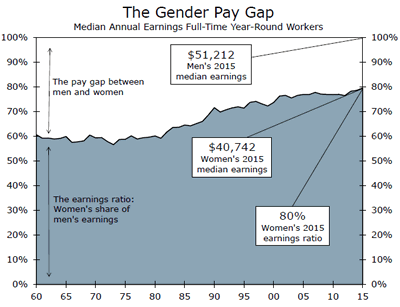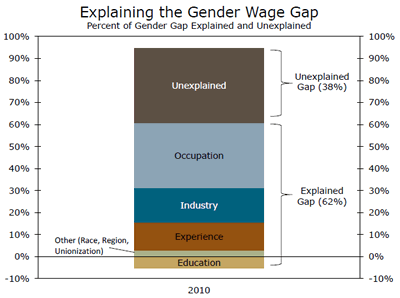U.S. Review
Employment Confirms Fed Is Set for a Hike in March
- Nonfarm employment rose by 235,000 in February amid strength in the goods producing sector.
- The unemployment rate fell to 4.7 percent while labor force participation climbed higher.
- Average hourly earnings rose 0.2 percent. While softer than expected, an upward revision to January lifted the year-overyear rate to 2.8 percent.
- The trade deficit widened to $48.5 billion in January as a $1.1 billion
Employment Confirms Fed Is Set for a Hike in March
The Fed remains well on track with the employment side of its mandate. Employers added 235,000 new jobs in February while hiring in January was revised higher. Over the past three months, hiring has averaged 209,000 and suggests that the trend in job growth has strengthened a bit since the second half of last year.
Hiring was wide spread in February, but particularly strong in the goods producing sector. Mining payrolls rose by 8,000, which was the largest increase since before oil prices began to collapse in mid-2014. In another sign that the factory sector is on firmer ground, manufacturing payrolls rose by 28,000 and are now up over the past year. Mild winter weather also appears to have boosted construction employment, which jumped by 58,000. Service sector employment was more in line with its recent trend, increasing by 140,000 last month.
Measures of unemployment indicated that slack in the labor market continued to decline. The headline unemployment rate fell back to 4.7 percent, while the broader U-6 measure, which includes workers outside the labor market who want a job and part-time workers who would prefer a full-time job, fell to 9.2 percent. At the same time, the labor force participation rate edged up despite the aging population. Looking at just prime age workers (ages 25-54), the participation rate in February rose to its highest level since 2011 and suggests that the stronger labor market is pulling in new workers.
With the unemployment rate signaling the labor market is near full employment, attention has shifted to wage growth. Although average hourly earnings in February came in a touch short of expectations by rising just 0.2 percent, January’s disappointing print was revised up a tick. Over the past year, wages are up 2.8 percent compared to a 2.4 percent increase this time last year. The pickup in wages should give the Fed confidence that the labor market is indeed at full employment and inflation pressures are slowly building. We see nothing in this report that prevents the FOMC from raising rates at next week’s meeting.
Trade Looks Set to be a Drag on Q1 GDP
Elsewhere this week, the trade deficit widened to $48.5 billion as a $1.1 billion increase in exports was swamped by a $5.3 billion jump in imports. Some of the widening reflects the recent pick up in import prices. Import prices have firmed over the past few months as oil prices have recovered, and prices for imported products have now increased more than export prices over the past year.
The impact of prices on the February trade balance, due next month, should be more muted. Import prices rose 0.2 percent in February as an increase in prices for agricultural products, consumer goods and industrial supplies more than offset a decline in petroleum prices. Export price inflation was slightly stronger at 0.3 percent. Looking through these price movements, however, the real trade balance looks set to widen over the first quarter and will likely be a drag on Q1 GDP.
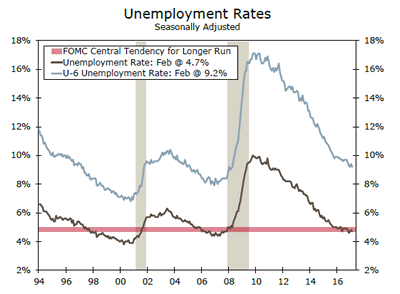
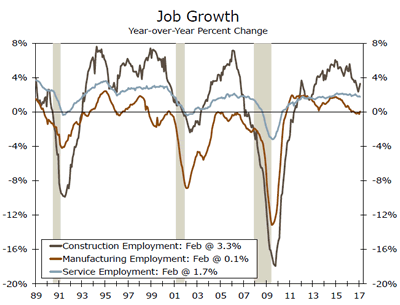
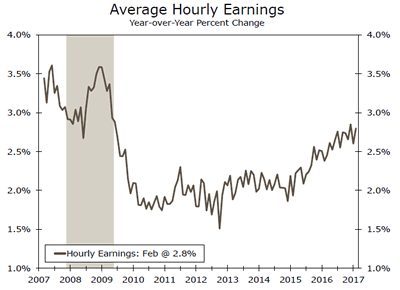
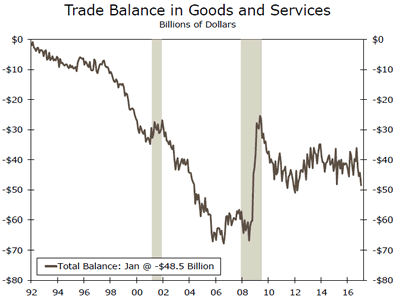
U.S. Outlook
Retail Sales • Wednesday
Retail sales got a strong start in 2017, increasing 0.4 percent in January after an upwardly revised 1.0 percent jump in December. January’s print came despite a soft reading for motor vehicle and part dealers’ sales and miscellaneous store retailers’ sales. Most other sales segments had strong sales in January, particularly gasoline stores, as gas prices continued to firm, and electronics, sporting goods and department stores posted solid growth after months of declines. January’s report generally supported the strong recovery indicated in the consumer surveys since the election.
Control group retail sales, which goes into the calculation of Personal Consumption Expenditures (PCE) within GDP, was also up 0.4 percent in January, which was a solid start to Q1. Retail sales are reported in nominal terms, so strength may be dampened somewhat when inflation is taken into account. Still, consumer demand remains well suited to drive growth this year.
Previous: 0.0% Wells Fargo: 0.1% Consensus: 0.1%
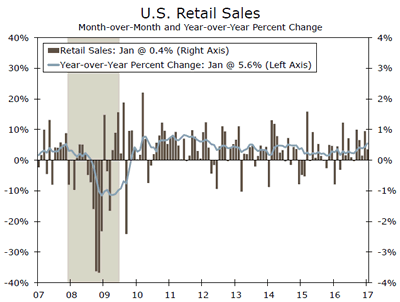
CPI • Wednesday
Inflation is increasingly approaching the Federal Reserve’s target. The January CPI report confirmed that, with prices up 0.6 percent on the month, and 0.3 percent when excluding the volatile food and energy component. Headline CPI inflation was up 2.5 percent over the year, while the core CPI was up 2.3 percent. The transitory effect of low oil prices is largely in the rearview mirror. Meanwhile, prices for food at home have yet to gain traction.
The PCE deflator, the Fed’s preferred inflation measure, which was released last week, showed a similar firming, with the core PCE gauge just below the 2 percent target. Recent inflation data have strengthened the case for a March rate hike. We expect February’s reading to show continued upward trend in consumer prices, rising 2.6 percent over the year, but unchanged on the month as we expect some giveback from January’s outsized jump.
Previous: 0.6% Wells Fargo: 0.0% Consensus: 0.0%
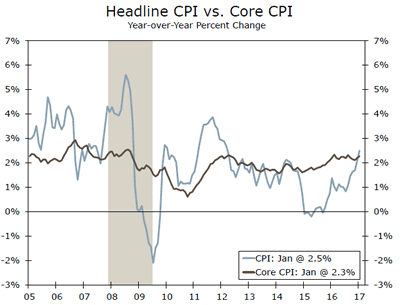
Industrial Production • Friday
January’s industrial production report was largely impacted by the weather, as a milder-than-usual winter weighed on utilities output. Total industrial production fell 0.3 percent in January, though the decline masked underlying strength in manufacturing output. Manufacturing production was up 0.2 percent, with particular strength in the machinery component—an encouraging sign for capital demand.
The downturn in factory activity that started in 2014 continues to fade into the rearview mirror, and the marked improvement since the election in sentiment measures for the sector gives more upside risk to the outlook. Still, we continue to keep our expectations in check, as a breakout in activity seems unlikely in the foreseeable future. We expect industrial production expanded somewhat in February, up 0.2 percent.
Previous: -0.3% Wells Fargo: 0.2% Consensus: 0.2%
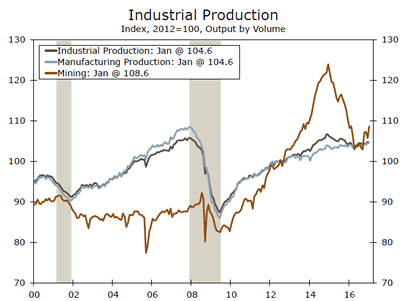
Global Review
Brazilian Economy Remains Depressed
- The Brazilian economy contracted for the second consecutive year in 2016. Although the downturn in the economy may come to an end this year, a return to the supercharged rates of growth that were the norm during the past decade do not look likely anytime soon.
Eurozone Economy Continues to Expand
- The economic expansion in the Eurozone is becoming more and more self-sustaining. Until the core rate of inflation starts to trend higher, however, the ECB likely will keep its foot firmly on the accelerator.
Brazilian Economy Remains Depressed
It was not that long ago that Brazil was regarded as one of the world’s high-flying economies. How times have changed! Data released this week showed that real GDP in Latin America’s largest economy fell 3.6 percent in 2016 which follows the 3.8 percent contraction registered in 2015 (see chart on front page). The Brazilian economy is now 9 percent smaller than it was at its peak in Q1-2014.
Fortunately, there are some tentative signs that the economy may be bottoming. For example, industrial production (IP) in Brazil has more or less stopped contracting. That said, there are few signs yet of recovery. If there is a silver lining to this story it is that the depressed state of the economy is leading to a sharp decline in inflation (top chart). Consequently, the central bank has reduced its main policy rate 200 bps since October, and most analysts look for further easing. Lower interest rates should eventually boost economic activity. That said, we expect that economic growth in Brazil will remain lackluster for the foreseeable future with real GDP growing less than 1 percent this year. Although the economy may accelerate somewhat next year, we believe that growth will remain well short of the 5 percent per annum rate that was the norm between 2004 and 2008.
Eurozone Economy Continues to Expand
Data released this week confirmed that real GDP in the Eurozone grew 0.4 percent (1.6 percent at an annualized rate) on a sequential basis in Q4-2016 (middle chart). The new "news" was the breakdown of the real GDP data into its underlying demand components, which showed that growth was broad-based, albeit a tad slow, in Q4. In short, it appears that the economic expansion in the Eurozone is more or less self-sustaining at present.
We estimate that real GDP in the euro area will grow at roughly the same rate in Q1 as it did in Q4 and that the modest pace of expansion will remain intact this year and in 2018. The purchasing managers’ indices for the manufacturing and service sectors currently stand at multi-year highs, although the limited "hard" data that we have for Q1 are not indicating quite the same degree of strength as the PMIs suggest.
The ECB held a policy meeting on Thursday and, as widely expected, it made no changes to its policy stance. The tone of this week’s statement was a bit more upbeat than the statement released after the last policy meeting in January as were President Draghi’s comments in his press conference. But ECB policymakers continue to acknowledge that the risks to the economic outlook remain "tilted to the downside."
The overall rate of CPI inflation in the euro area shot up to a 4-year high of 2.0 percent in February (bottom chart). But the underlying rate of inflation, as measured by the core inflation rate, remains subdued and trendless. Until the core rate of inflation starts to trend higher, the ECB likely will keep its foot firmly on the accelerator with continued purchases of bonds through its quantitative easing program.
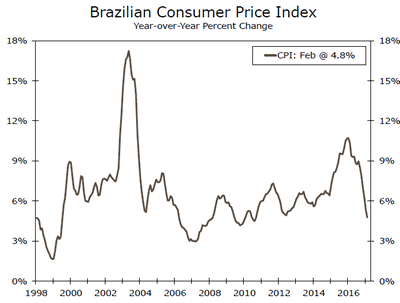
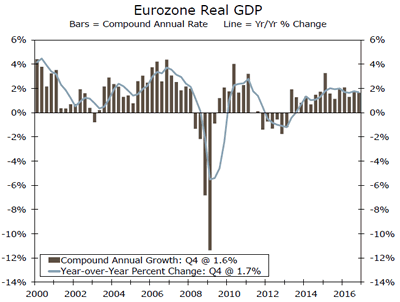
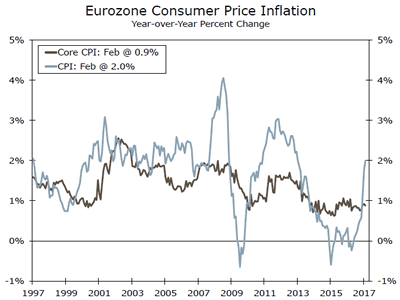
Global Outlook
Mexican Industrial Production • Tuesday
Mexican industrial production (IP) declined 0.1 percent in December from the prior month as slumping mining production and construction activity offset monthly gains in factory production. Weakness in mining production was concentrated in oil and gas output, which fell 2.4 percent—the largest decline since April 2015. However, the year-over-year result reveals a weak performing industrial sector, which fell 0.6 percent. The largest declines were in the mining sector, down 6.4 percent, while utilities and construction activity are up 3.3 percent and 1.8 percent, respectively. The all-important manufacturing sector has fared better, boosted by the depreciation of the peso, which we expect to have carried over into the beginning of 2017. That said, markets look for total IP to have started the year on an even weaker note.
Previous: -0.6% Consensus: -0.4% (Year-over-Year)
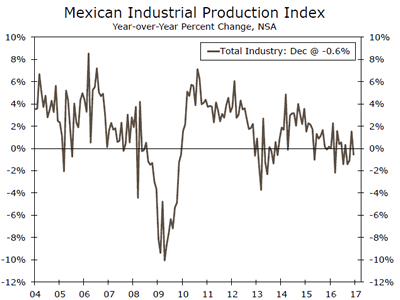
Australian Employment • Wednesday
Australian employment added a net 13,700 new jobs in January following an upwardly revised December print, besting market expectations of a more modest 9,700 increase. Despite the gain, full-time employment tumbled by 44,500 in January, offsetting December’s downwardly revised gain. Part-time, once again, contributed to monthly gains, adding 58,200 jobs, and also helped drive down the unemployment rate to 5.7 percent. The participation rate has also trended lower, falling to 64.6 percent over the month. Australia’s labor market has been quite volatile over the past few years with the divergence between full- and part-time job growths becoming more pronounced due to businesses shifting to more part-time positions, which have also compressed wage growth. As such, consensus expects the Australian labor market to continue to improve and add 18,000 net new jobs in February.
Previous: 13,700 Consensus: 16,500
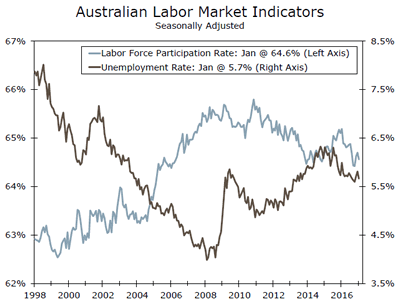
Bank of England Bank Rate • Thursday
Since lowering its main policy rate to 0.25 percent on August 4 and increasing the size of its quantitative easing program, the Monetary Policy Committee (MPC) of the Bank of England (BoE) has held rates unchanged. Economic growth in the United Kingdom has held up quite well since the Brexit referendum vote, increasing 0.6 percent in Q4-2016. Moreover, the British labor market has tightened somewhat in recent months, wages have shown some signs of acceleration and inflation has edged higher toward the target range. With improving economic conditions, the BoE has revised up its forecasted growth rate to 2.0 percent from 1.4 percent for 2017. That said, with the uncertainty still surrounding the Brexit negotiations, we believe that the MPC will refrain from raising rates at its meeting next week, leaving it unchanged at 0.25 percent.
Previous: 0.25% Wells Fargo: 0.25% Consensus: 0.25%
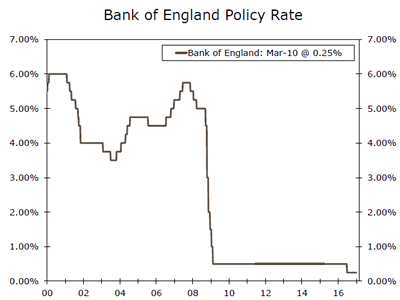
Point of View
Interest Rate Watch
Fed as Preemptive
Recent rapid changes in market expectations regarding FOMC action have raised the probability of a move to raise the fed funds rate next week. In part, this appears as the FOMC being preemptive in expectation of rising inflation for the period ahead. While we agree that March is likely to see an increase in the funds rate, projections of more rapid and continued FOMC action remain less probable.
Can We Quantify?
Market commentary that FOMC tightening will be more rapid and greater than market expectations are notoriously nebulous and, without actual numbers, are simply not effective for decision making.
One issue is the actual inflation numbers. As illustrated in the top graph, there is a clear seasonal pattern in inflation. Inflation has a distinct seasonal pattern of a jump in Q1 prices, and then a slower pace for the rest of the year. The jumps early in recent years are noticeable.
Expectations Then Deliverance?
Equity market reactions have clearly indicated that market participants expect an improvement in the economy and the earnings/valuations of private companies (middle graph). Our expectation is that such market reactions reflect the influence of anticipated tax cuts, deregulation and a host of other animal spirit changes in attitudes. However, we remain cautious about the actual delivery of policy changes in 2017 as outlined in our annual report last December.
Countervailing Forces
For every action there is an equal reaction. With expectations for better economic growth has come a rise in both interest rates and the dollar (bottom graph). In one part, the market is doing some of the FOMC’s bidding. In the second part, the stronger dollar will offset some of the economic stimulus anticipated by the market. In both cases, these actions suggest that the magnitude and speed of FOMC action will not match the extent of the concerns revealed in recent market commentary. Talk is cheap—let’s see some numbers.
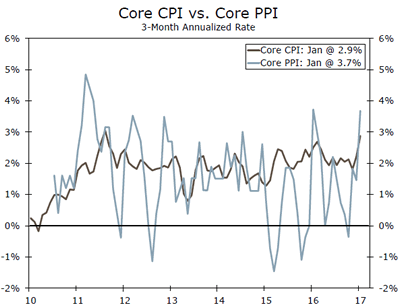
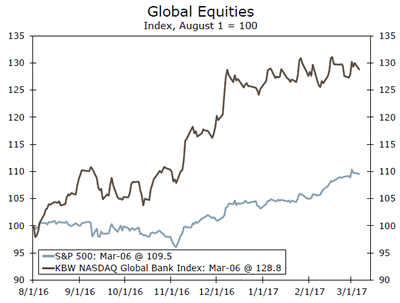
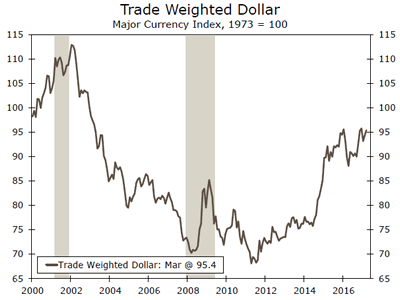
Credit Market Insights
Mortgage Market’s Small Credit Box
In the wake of the housing crisis, lending standards for residential mortgage loans tightened significantly. The mortgage market saw a sharp pullback in lending, with the Mortgage Bankers Association’s Mortgage Credit Availability Index declining roughly 85 percent from 2006 to 2008. Credit availability has improved in recent years; however, qualifying for a mortgage still remains a far stretch for many borrowers.
While tighter lending standards have been witnessed across the credit spectrum, borrowers with lower scores have seen the greatest impact. Data from the Federal Reserve Bank of New York’s Household Debt and Credit Report shows borrowers with upper-range credit scores (72o or higher) accounted for 75 percent of mortgage originations in 2016 up from just 24 percent in 2006. At the same time, the lowest-tier credit score (10th percentile) for mortgage borrowers spiked from 580 in 2006 to 650 in 2016. Meaning, the tightening of mortgage lending standards has led to a general reduction in lending to borrowers with low credit scores.
While stricter lending conditions have reduced default rates and improved balance sheets, the decrease in credit availability has also restricted a more robust recovery in housing. In the Federal Reserve’s Report on the Economic Well- Being of U.S. Households, renters’ most common responses for not owning a home included "they cannot afford a down payment" (50 percent), and that "they cannot qualify for a mortgage" (31 percent).
Topic of the Week
The Girl with the Draggin’ W-2
While broad wage growth has improved in recent years, the topline numbers hide substantial variations in earnings between women and men. Women earn just 80 cents for every dollar earned by men (top chart). While this frequently cited figure is accurate, it is somewhat blunt in its measurement as the causes of the gender pay gap are multi-faceted.
Some, but not all of the wage gap, can be explained by observable differences in men’s and women’s work patterns. Women have less experience in the workforce relative to men, evidenced by lower labor force participation rates. However brief, time spent out of the workforce slows the accumulation of job-specific skills. Among women who do work, they are more likely to work part time. This comes as women still spend 50 percent more time each day than men on housework and family care. Industry and occupational variations also play a role. However, even in traditionally female jobs, such as teaching and nursing, men earn more. If not for the fact that women are now out-achieving men educationally, the pay gap would be even larger.
Nearly 40 percent of the pay gap remains unexplained by these factors, however (bottom chart). Research suggests unconscious biases, lack of sponsors, penalties for working more flexible hours and stigmas when negotiating pay also play a role in the pay disparity.
Closing the gender pay gap should be more than just a social goal. For businesses, research has shown it is a way to boost profits and tap a deeper pool of talent. For the larger economy, narrowing the pay gap could draw more women into the workforce and increase labor force participation, an oft-cited factor in explaining belowtrend GDP growth. Raising female participation and earnings would support income and spending, particularly for low-income households.
